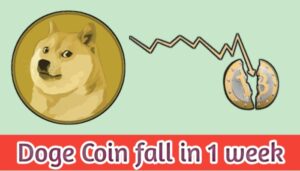Doge Coin Fall in 1 Week Dogecoin (DOGE) fell in a short time-frame (one week) including the contributing factors, technical signals, and broader context. This is for informational purposes only not financial advice.
1. Overview: What happened with Dogecoin in the last week
In recent days DOGE has shown a noticeable drop in price. For example, one analysis notes the price declined from about $0.2889 to $0.2631 in a span of days, as part of increased selling pressure.
While the exact magnitude of the drop depends on the precise week chosen, the move is significant for a meme-coin such as Dogecoin and triggers questions about why.
2. Key contributing causes
The fall is not caused by a single factor, but by several interlinked reasons. I’ll break these down into major categories:
2.1 Profit-taking and short-term trader exit
Doge Coin Fall in 1 Week One major driver: after a preceding price rise, many short-term holders chose to cash out. For example, a report noted that Dogecoin “fell 14% as profit-taking at a 6-month high” occurred.
When profits are taken, this increases sell pressure, which can trigger further declines if enough participants exit.
2.2 Technical breakdowns and bearish signals
Technical indicators show weakness:
- A “death cross” (short-term moving average crossing below a longer-term moving average) formed on DOGE’s chart on an hourly basis, signalling bearish momentum.
- Price failed to hold above certain support levels (e.g., around $0.26) and slipped below key moving averages (e.g., 20-day EMA).
When technicals degrade, algorithmic and discretionary traders may respond by selling, compounding the drop.
2.3 Weakening sentiment & speculative nature
DOGE, like many “meme coins”, is heavily sentiment-driven. Some of the sentiment signals:
- The funding rate for DOGE (in derivatives markets) turned negative, meaning more traders were betting on a price decline.
- Network metrics show the coin’s speculative nature: e.g., high NVT ratio (market cap/growth of transactions) indicates valuation outpacing actual usage.
- General crypto market risk-off mode: if broader markets are uneasy, speculative assets such as DOGE tend to suffer.
Thus, when sentiment tilts negative or becomes cautious, a coin like DOGE is more vulnerable.
2.4 Broader macroeconomic & market environment
Even though DOGE has its idiosyncratic factors, the wider crypto market environment matters. Some relevant points:
- If major cryptocurrencies are under pressure (bitcoin, ethereum, etc.), altcoins/ meme coins often follow.
- Regulatory uncertainty, interest-rate expectations, and liquidity conditions all feed into crypto sentiment. E.g., some analysis states that when “broader market sentiment is bearish … demand for Dogecoin decreases”.
- Specific news items may amplify risk perception (though in the specific week under study one may need to check exact headlines).
2.5 Utility / fundamental limitations
While DOGE is one of the largest and most recognised meme coins, from a “fundamental usage” perspective it has limitations:
- No supply cap (i.e., unlimited issuance) which some critics say undermines long-term store-of-value arguments.
- Relatively limited “real world” adoption compared to major utility-coins.
Because of this, when speculative momentum wanes, there is less of a fundamental anchor to hold up price.
2.6 Specific triggers & resistance failures
In the week under review, DOGE failed to breach or hold above key resistance/support levels:
- One analysis mentions the price dropping from ~$0.2889 to $0.2631 amid a death cross formation.
- Another look notes that despite positive news (like the launch of a DOGE-related ETF), price was rejected and slipped below the 20-day EMA, signalling vulnerability.
When a known “good news” does not spark a rally (or is muted), investor disappointment can contribute to selling.
3. Sequence of events in the one-week drop
To understand how the drop plays out, here is a plausible sequence (based on public analysis) of how the one-week fall might unfold:
- Prior to the drop, DOGE had experienced some bullish momentum (or at least elevated hopes) — for example, discussions of new ETF exposure, strong community interest.
- As profit-taking begins (holders sell to lock in gains), price begins to flatten or decline.
- Technicals begin to show warning signs (e.g., moving averages flatten, support levels tested).
- A trigger event (could be macro news, failed resistance break, large holder selling) causes a sharper move down.
- Sentiment shifts: more traders believe the drop will continue; funding rates turn negative; speculative demand dries up.
- Price drops to lower support; some panic or stop-loss selling occurs, amplifying the move.
- After the week, the coin is noticeably down, technicals are weak, and investor mood is cautious.
For example, one article noted the move from $0.2889 to $0.2631 in a few days amid the death cross.
4. What to watch / support & resistance levels
Doge Coin Fall in 1 Week a drop like this happens, investors and analysts often look at certain key levels and metrics to assess whether the coin may stabilise or fall further.
- Support levels: In the recent analysis, the $0.26 region was cited as key. If price drops significantly below that, the next support might be lower (for example $0.22 in one forecast).
- Resistance levels: For a rebound, breaking above e.g., $0.274 or $0.288 could be important.
- Technical signals: Watch moving averages (20-day EMA, 50, 200), volume spikes, whether a death cross is confirmed. If DOGE climbs above its EMAs with volume, that might signal a reversal.
- On-chain/market metrics: Funding rate turning positive again, increase in long-term holder accumulation, reduction in short-term holder losses.
- Sentiment / news flow: New positive catalysts (e.g., adoption news, exchange listings, institutional flows) could change the mood.
One article opined: if DOGE reclaims $0.245 as support then a push toward $0.268 might happen.
5. Why the drop matters (for DOGE and the broader market)
Here are some implications of such a drop:
- Confidence: For a meme coin like DOGE, confidence plays a major role. A drop signals to many traders that “the party may be over (for now)”.
- Volatility risk: Investors should recognise the higher risk associated with such assets. The drop underscores the fact that gains aren’t assured.
- Broader crypto sentiment: When a large, well-known coin like DOGE falls, it can reflect or contribute to weakening sentiment across the crypto space.
- Liquidity & psychology: Large holders (whales) might use the drop as an opportunity to exit; retail investors might be discouraged.
- Utility question: Repeated drops without strong rebound may raise questions about a coin’s long-term viability or role.
6. Key underlying risks to be aware of
If you are considering exposure to DOGE (or similar coins), here are some of the risks highlighted by this drop:
- Speculation > fundamentals: DOGE’s value is heavily driven by speculation, community hype, and sentiment; when those fade, downside risk increases.
- Limited utility / inflation risk: As mentioned, DOGE’s unlimited supply can work against it in the long term.
- Macro & regulatory exposure: Crypto markets remain sensitive to macro factors (interest rates, regulation, exchange issues).
- Technical traps: Even when good news appears, if price fails to respond, that can lead to disappointment and reversal. For example, the ETF launch did not produce a strong rally for DOGE.
- Liquidity & stop-loss cascades: Drops may trigger cascading sales via stop-losses, algorithmic selling, or margin liquidations in derivatives markets (funding rate going negative is one sign).
7. Could DOGE rebound? What might it take
Despite the fall, whether DOGE recovers depends on several factors:
- Renewed positive catalyst: Something that shifts sentiment, such as major adoption news, institutional investment, or broader crypto market rally.
- Technical breakout: Holding support and moving above key resistance with volume could signal a reversal.
- Sustained accumulation by long-term holders: If whales or large holders accumulate rather than sell, that adds support.
- Improvement in usage/utility: Though harder with a meme coin, any development that ties DOGE more to usage may help.
Some analysts noted that if DOGE holds $0.26 support and shows strong buy signals, a breakout to $0.30 could be possible.
8. A word of caution: Not all drops are the same
Doge Coin Fall in 1 Week It’s important to emphasise that each price drop has its context. While this drop shares many features with previous ones (profit-taking, technical weakness, sentiment decline), there could be unique aspects this time (e.g., the ETF launch context, large holder behaviour). As one blog notes: “This drop wasn’t attributed to a single reason, but rather a combination …”
Hence, treating the drop as a “normal correction” is risky; understanding the full context is key.
9. Summary & takeaway
To summarise:
- DOGE’s recent one-week fall is due to a confluence of factors: profit-taking, a technical breakdown (death cross, support failure), shift in sentiment and speculative mood, broader market pressures, and limitations in fundamentals.
- Key technical levels were breached (e.g., support around $0.26), and sentiment metrics (funding rate, NVT ratio) signalled increased risk of further decline.
- The drop matters because DOGE is a high-volatility, high-speculation asset; repeated declines without rebound can affect investor confidence and carry risk of significant losses.
- A rebound is possible but will likely require strong positive catalyst + technical breakout + improved sentiment.
- Anyone participating in DOGE needs to be aware of the speculative nature and risks involved; “memecoins” can move fast both up and down.
Conclusion
Doge Coin Fall in 1 Week The recent one-week fall of Dogecoin highlights the volatile and sentiment-driven nature of meme coins. What began as a mild correction quickly turned into a deeper decline due to profit-taking, weak technical signals, and fading market optimism. Once major support levels were broken, automated selling and panic among short-term traders accelerated the drop.
Beyond technical reasons, the fall also reflects broader challenges within the crypto market — uncertainty over regulations, rising global interest rates, and shifting investor focus toward more fundamentally strong projects. Dogecoin’s lack of intrinsic utility and unlimited supply further magnify its vulnerability when enthusiasm cools down.
However, history shows that Dogecoin has recovered from similar dips before. Its large community, cultural relevance, and recognition as a pioneer among meme coins still give it potential for future comebacks — if overall crypto sentiment turns bullish again.
In short, Dogecoin’s one-week decline is a reminder that while meme coins can deliver impressive rallies, they can also experience sharp reversals in a matter of days. For investors, this episode underlines the importance of risk management, patience, and understanding that hype-based assets are highly unpredictable. Sustainable growth for DOGE will depend not only on social media momentum but also on stronger adoption, technical innovation, and a more stable crypto environment.

















